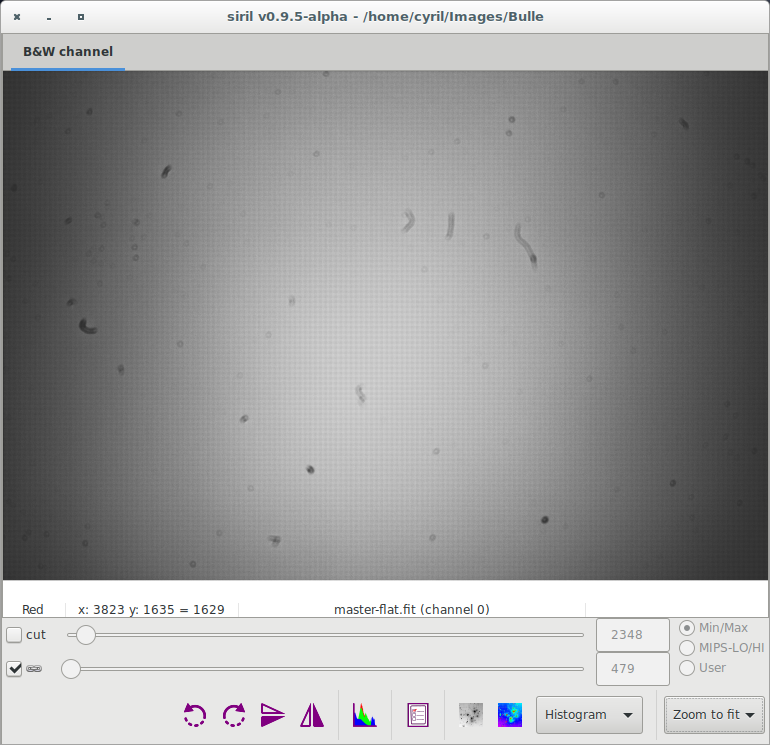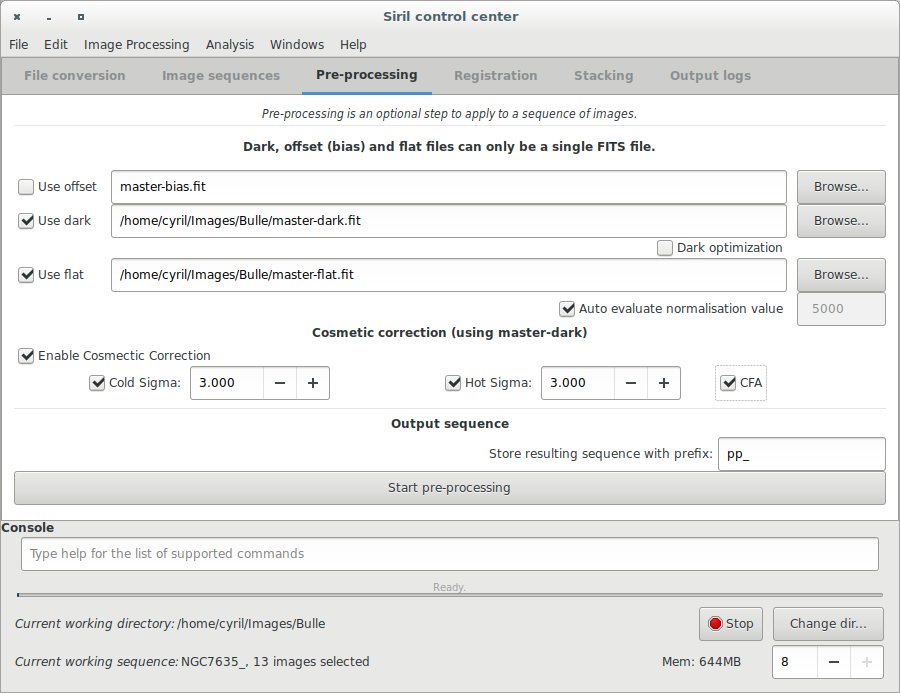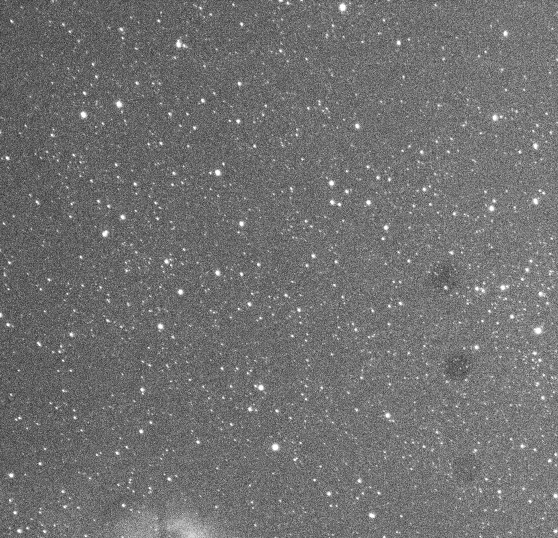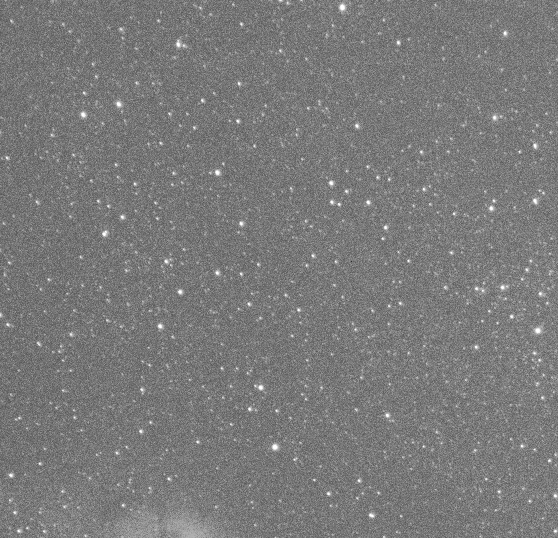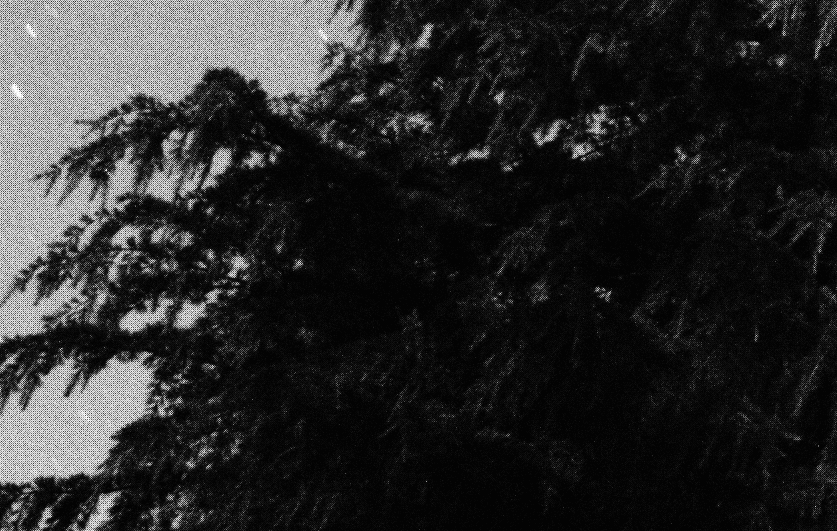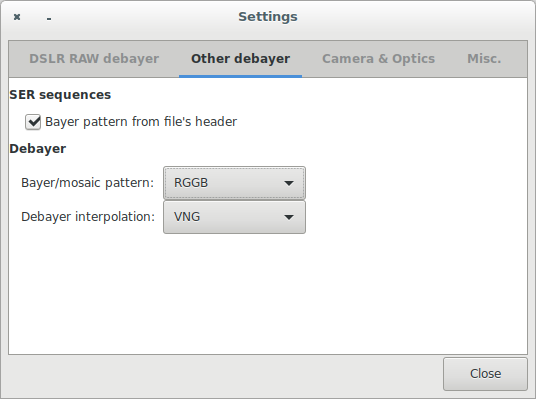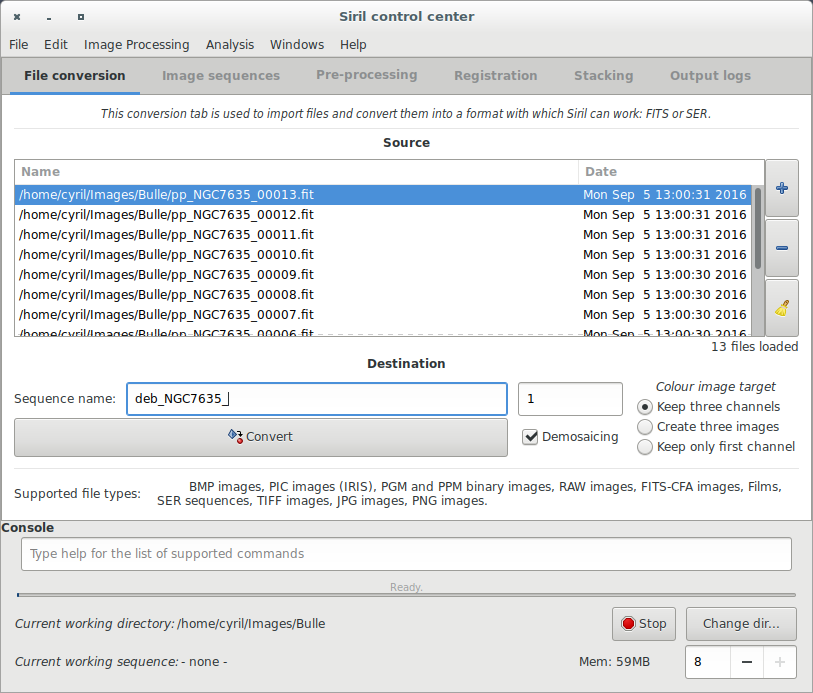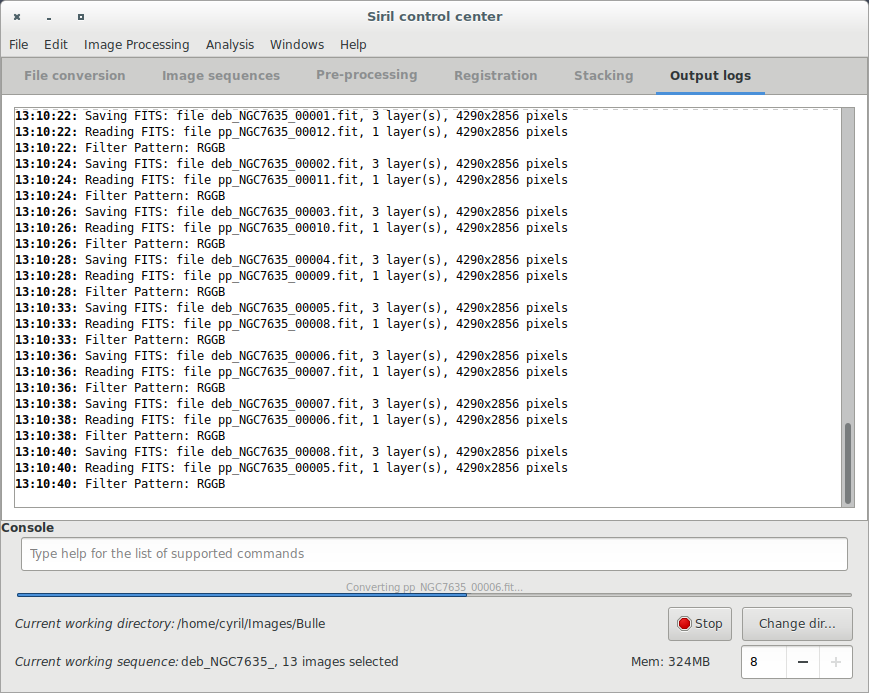Prétraitement
- Convert your images in the FITS format Siril uses (image import)
- Work on a sequence of converted images
- → Pre-processing images
- Registration (Global star alignment)
- Stacking
Pré-traiter ses images
Lorsqu'une séquence est chargée, les images peuvent être pré-traitées. Le pré-traitement est une étape optionnelle mais fortement recommandée. Elle implique de posséder des images darks (noires), offsets/bias (Décharge) et flats (PLU). La façon dont sont créés les master est décrite dans cette rubrique, voir aussi la partie sur l'empilement.
- BIAS (OFFSET)
Une image BIAS est une image prise dans le noir total (capuchon fermé) et à la vitesse la plus rapide. En pratique, sur les appareils photos reflex modernes, cela correspond à la vitesse de 1/4000s. Le BIAS va contenir le bruit électronique ainsi que le signal de lecture de l'appareil photo. Afin d'introduire le moins possible de bruit dans l'image pré-traitée, il est recommandé de prendre un grand nombre d'images BIAS (>20), d'autant plus que leur prise est simple et rapide. Enfin, notez que la prise des BIAS doivent se faire au même ISO que les images à pré-traiter. Aussi veillez a empiler vos BIAS avec un algorithme médian ou à moyenne avec rejet de pixels déviants tel que le Winsorized Sigma Clipping proposé dans Siril. Faites attention à ce que les niveaux de rejet ne dépassent pas 0.5%, et surtout choisissez "No Normalization".
Voici un master BIAS calculé à partir de 10 images avec un empilement Winsorized Sigma Clipping.

12:58:34: Pixel rejection in channel #0: 0.368% - 0.354%
12:58:34: Integration of 10 images:
12:58:34: Normalization ............. None
12:58:34: Pixel rejection ........... Winsorized sigma clipping
12:58:34: Rejection parameters ...... low=3.200 high=3.300
- DARK
Les images darks sont prises avec un temps d'exposition et un ISO identiques aux images à pré-traiter, mais dans le noir. Encore une fois, vous pouvez utiliser le capuchon de l'objectif ou bien celui du télescope. Ils doivent également être fait à une température très proche des images enregistrées. C'est pour ça qu'il est recommandé de les faire en tout fin de session ou bien au milieu. De la même façon que pour les BIAS, plus le nombre d'images dark enregistrées sera important et moins le bruit ajouté aux images pré-traitées sera important. La encore, empilez les darks avec un algorithm médian ou bien Winsorized Sigma Clipping (en vérifiant toujours les niveaux de rejet en fin de processus) et faites attention de ne toujours pas faire de normalisation.
WARNING: Remember that dark frames are always composed from real dark signal and bias signal. If you don't apply dark optimization, you can leave the bias signal and your masterDark will be in fact [math]\displaystyle{ masterDark + masterBias }[/math]. In consequence subtracting this master to the light frames will remove both signals. However, applying dark optimization makes things different by multiplying masterDark by a coefficient factor not equal to 1. In this case, you must subtract masterBias from each dark frame.
Voici un master dark obtenu à partir de 10 images avec un empilement Winsorized Sigma Clipping.
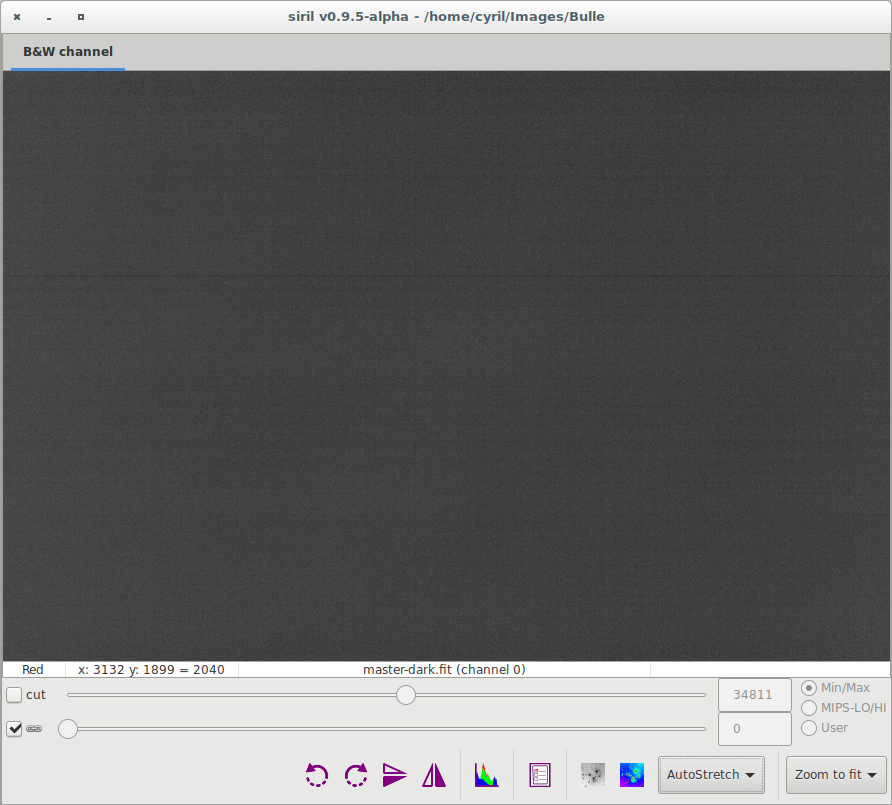
13:00:40: Pixel rejection in channel #0: 0.340% - 0.384%
13:00:40: Integration of 10 images:
13:00:40: Normalization ............. None
13:00:40: Pixel rejection ........... Winsorized sigma clipping
13:00:40: Rejection parameters ...... low=3.200 high=3.300
- FLAT
Un instrument optique n'illumine pas le capteur de façon homogène. De plus, les poussières présentes sur ce dernier peuvent conduire à l'apparition de taches sur les images. Pour corriger ces effets, nous avons besoin de diviser chaque image par un master flat. Le master flat est obtenu à partir de la combinaison médiane d'images d'une zone lumineuse uniforme (en général le fond de ciel au crépuscule ou à l'aube), prise avec un temps de pose court.
WARNING: Remember that flat frames are always composed from real flat signal and bias signal. So you must subtract master-bias from each flat frames to obtain real master-flat. In addition, if flat frame exposures are too long, a dark-flat signal should also be removed.
Siril évalue de façon automatique un coefficient de normalisation utilisé pendant la division du master FLAT. Cependant cette valeur peut être définie manuellement.
The master flat frame should be created by stacking flat frames with the median algorithm (or Winsorized by checking the rejection levels at the end of the process, which should be lower than 0.500), and choose Multiplicative normalisation.
Voici un master flat calculé à partir de 9 images avec l'empilement Winsorized Sigma Clipping. Notez que les vignettages et les poussières sont fortement visible. On remarque également la structure typique de la matrice de Bayer.
13:05:23: Pixel rejection in channel #0: 0.388% - 0.304%
13:05:23: Integration of 9 images:
13:05:23: Normalization ............. multiplicative
13:05:23: Pixel rejection ........... Winsorized sigma clipping
13:05:23: Rejection parameters ...... low=3.400 high=3.700
Pre-processing
The preprocessing operation consists in computing the following equation:
calibrated image [math]\displaystyle{ = \frac{light - masterDark - masterBias}{masterFlat - masterFlatDark - masterBias} }[/math]
For DSLR images, when dark optimization is not used and masterFlatDark not needed, one good method is to process like that:
- Integrate all bias to build master-bias
- Integrate all darks to build master-dark
- Calibrate flat frames with master-bias
- Integrate all calibrated flat to build master-flat
- Preprocess light frame with master-dark and master-flat
If you want to do the whole processing batch, once again with no masterFlatDark but with dark optimization, you must remove the master-bias from the master-dark before:
- Integrate all bias to build master-bias
- Calibrate dark frames with master-bias
- Integrate all calibrated darks to build master-dark
- Calibrate flat frames with master-bias
- Integrate all calibrated flat to build master-flat
- Preprocess light frame with master-bias, master-dark and master-flat
The pre-processing does not overwrites original FITS files from the sequence but creates new FITS files with the pre-processed data. The new file names are the same than the original prefixed with pp_ if you leave the default value in the prefix box. Below is an example of pre-processing using offset and dark files. Make sure that loaded sequence is the sequence of your light frames. Also, note that at the end of the process, the new sequence is automatically loaded.
Since 0.9.2 version, a new tool is available in the preprocessing tab: cosmetic correction. This tool search deviant pixels through master-dark and will correct them. You always should use this tool if you own master-dark. Please, pay attention to the CFA box. Check it if your monochrome pictures are CFA images. If you don't have master-dark (which should be avoided), you could use automatic cosmetic correction tool available through the "image processing" menu.
Results examples
Le résultat du pré-traitement appliqué à une image est donné dans l'exemple ci-dessous. Notez comment les poussières ont été supprimées.
Un autre exemple d'un pré-traitement réussi est donné en illustration ci-après. Notez comment le signal thermique a été supprimé.
Special case of demosaicing
- Demosaicing (for Bayer-Pattern images only)
Last step in pre-processing images consist in getting back Red, Green and Blue channels using interpolation algorithms. To do that, Siril gives the choice between 5 different algorithms.
- VNG (default)
- Bilinear (low quality but fast)
- Nearest neighboor
- AHD
- Super Pixel (no interpolation, the pattern RGGB, or other, is used as a super pixel and the image size is divided by four).
Make your choice in the window below by clicking on Settings and Other Debayer tab.
Pour procéder au dématriçage, retournez à l'onglet "Conversion" et remplissez les champs comme dans l'exemple ci-dessous :
Then check the Demosaicing button and click on the Convert Button right after. The demosaicing process should start and will take some time following the method you used and the CPU you own.
Finally you will have a new set of pre-processed light frames, automatically loaded in Siril, that you could register. Please note that at this stage you always have a lot of noise in your image. Indeed, pre-processing images with Dark, Bias and Flat do not remove noise but unwanted signal. The following Picture shows you the result of demosaicing. It is displayed in Auto-stretch visualisation mode in order to enhanced the visibility of signal but without altering your image.
Next item of the tutorial: Registration (manual image alignment).
